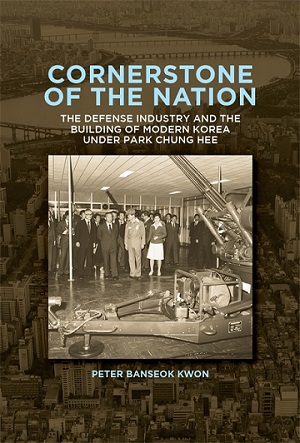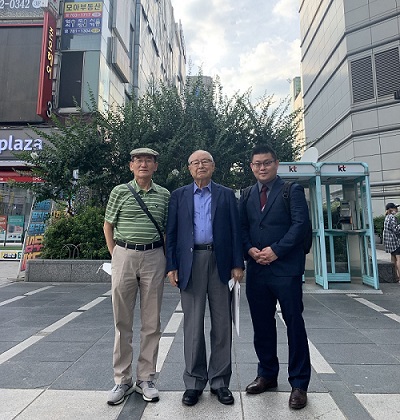UAlbany Professor’s Book Details Secret Weapons Program that Helped Build Modern Korea
By Bethany Bump
ALBANY, N.Y. (March 30, 2023) — Peter Kwon was at the Presidential Archives in South Korea in 2012 conducting field research for a dissertation he planned to write on Korean regional social movements when he stumbled upon a trove of recently declassified government documents.
The documents held details about the history of Korea’s defense industry that Kwon, then a PhD candidate at Harvard University and a visiting researcher at the Academy of Korean Studies, had never seen or heard of before. And they were eye-popping — details of secret weapons operations taking place against the wishes of the United States and other allies throughout the 1970s.
“The U.S. was opposed to South Korea's militarization and development of new weapons because it could escalate tensions between North and South Korea and trigger an arms race in East Asia," said Kwon, who joined the University at Albany as an assistant professor of Korean Studies in 2018. “And South Korea not only tried to develop the conventional weapons, but the nuclear missile also, which was banned by the United States.”
It was then Kwon decided to change the topic of his dissertation. He was riveted and wound up spending the next decade visiting Korea on a regular basis to read up on newly declassified materials and to interview generations of older Koreans who worked on these weapons programs.

In a new book out early next year, Cornerstone of the Nation: The Defense Industry and the Building of Modern Korea under Park Chung Hee, Kwon uses his decade’s worth of research to provide the first historical account of how Park’s secret program to build an independent defense industry spurred rapid militarization, industrialization and economic growth, and set the stage for South Korea to become the global economic powerhouse we know today.
Scholars have dubbed this period of rapid economic growth, during which South Korea went from one of the poorest nations in the world to the richest in just a few short decades, as the “Miracle on the Han River” — a nod to West Germany’s “Miracle on the Rhine” rebirth following World War II. But few have detailed just how extensively this growth was tied to South Korea’s militarization.
“Most people think that only North Korea is militarized because North Korea, of course, makes international headlines with its missiles and military threats,” Kwon said.
A Budding Defense Industry
Although the Korean War ended in 1953, a peace treaty was never signed and the two Koreas remained divided. In the years that followed, South Korea remained reliant on military aid from the U.S. and other allies to stave off threats from the north. But the introduction of the Nixon Doctrine in 1969 threatened the withdrawal of U.S. troops from Korea and Park, who was president at the time, sought to build up the nation’s defense industry through a total mobilization of business, science, labor and citizenry.
Companies like Samsung, LG, Hyundai and Kia were deployed to manufacture technologies in heavy and chemical industries such as steel, petrochemicals, special metals, machinery, shipbuilding and more. These technologies had dual purposes for both military and commercial use, allowing industrial complexes to develop and spin out of each.
“South Korea was in a very desperate position at the time,” said Kwon. “Until the early 1970s, they could not even produce their own guns and ammunition, and all weapons were imported from the United States. They had no original blueprints and very little technology, and had to start from the ground up with very limited U.S. military aid.”
To get around this, the government deployed engineers and other skilled workers to reverse engineer the weapons — a dangerous process that involved disassembling U.S. model weapons, hand-drawing blueprints of each weapon part, manufacturing each part, and then assembling them together as a full product.
“There was a lot of trials and errors, a lot of accidents,” Kwon said. “Since the original (U.S.) blueprints were unavailable, most of the weapons had to be made without them, leading to dangerous experiments and explosions.”
Building Trust
Kwon interviewed the engineers and laborers who worked on these classified projects, as well as top military scientists and former government officials — a lengthy process that involved building rapport through trusted intermediaries and multiple meetings.
“These people are now in their 70s and 80s,” he said. “Back in their day they were not allowed to share anything, or else they would have been punished and imprisoned. But now the times have changed. They no longer live under the censorship of the military regimes. They now want their stories to be told.”

Park was a polarizing figure who led an authoritarian regime and ruled with an iron grip, resulting in economic growth but at the expense of democratic progress, Kwon said. He was assassinated in 1979.
As democracy has grown in South Korea in recent decades, the government has made an effort to declassify materials from prior regimes. The first set of materials Kwon found were declassified around 2012, and he has continued to visit Korea every year or so since then to examine the latest declassified documents.
“South Korea is a very rare story,” he said. “The fact that it achieved both defense, industry development and rapid economic industrialization simultaneously within less than a decade is sort of unprecedented. While Koreans had learned from a similar strategy used by Japan and the United States in prior years, South Korea's model of economic development completely synchronized militarization and capitalist growth at a more accelerated pace, making its case distinct. And the story has not been widely told due to the sensitive nature of the topic and the polarizing legacy of Park. So I hope it will make an important contribution to Korean studies and to global military history because it’s such a unique case.”
Kwon’s book is scheduled for release in February 2024. It received grant support from the Academy of Korean Studies and the Association for Asian Studies, and will be published by Harvard University Asia Center and distributed by Harvard University Press as part of their East Asian Monograph series.




